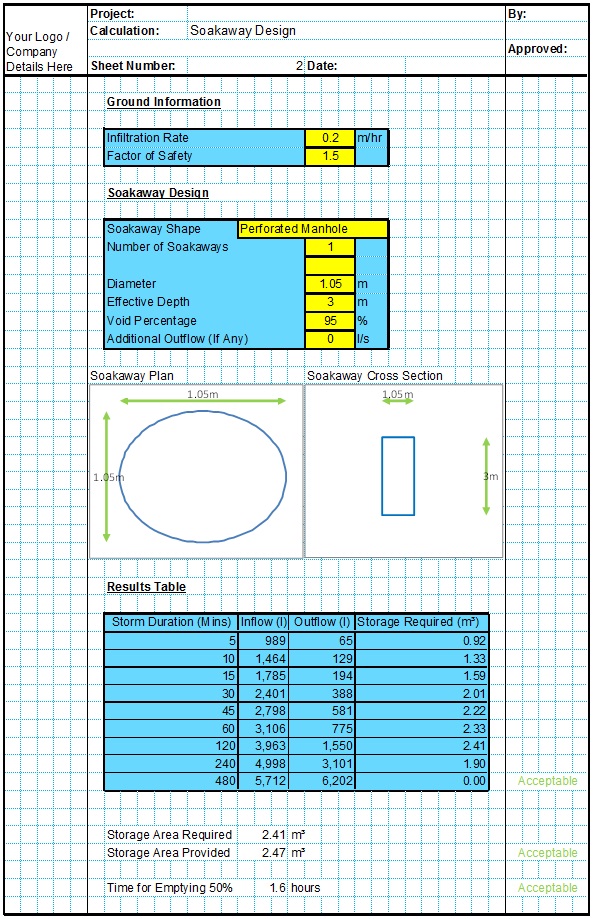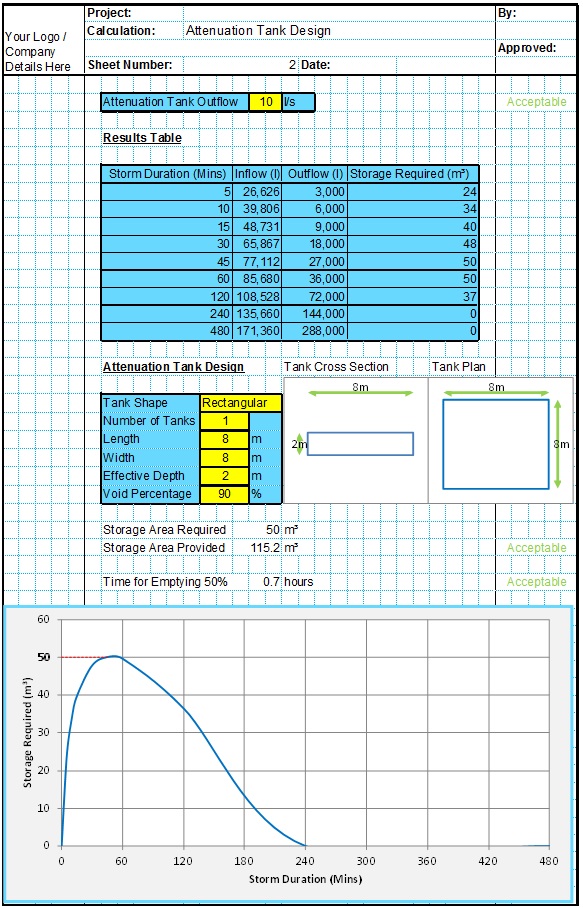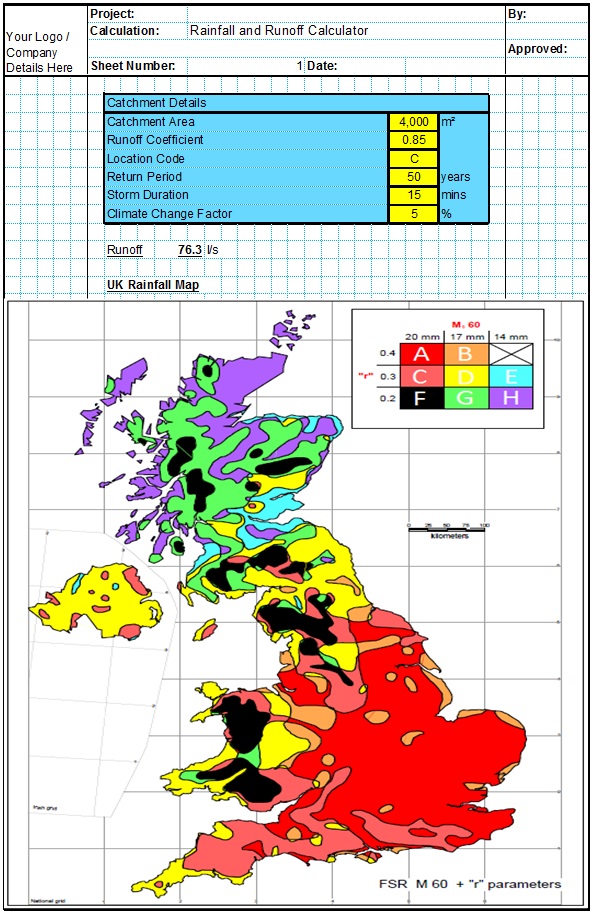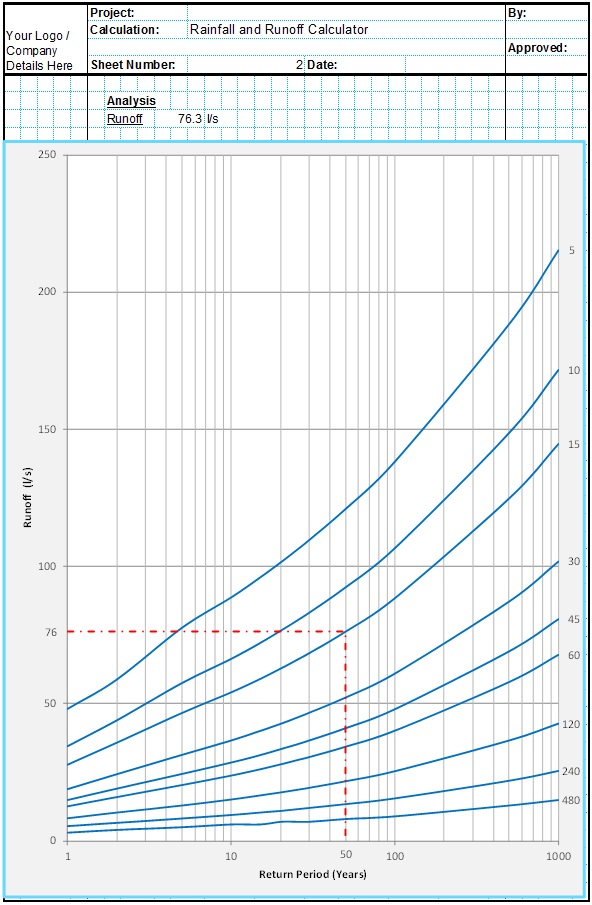The Factor of Safety used in the CIRIA R156 method and in the CivilWeb Soakaway Design Spreadsheet relates to the design infiltration rate. There is always a level of uncertainty regarding the infiltration rate of the soil, particularly as this rate often decreases significantly with time as the soakaway and surrounding soils become clogged with sediments and fine materials. This effect is increased if the soakaway is poorly maintained.
Factor of Safety Considerations
The Factor of Safety adopted for design can depend on a number of conditions, including;
- The confidence the designer has in the chosen infiltration rate. This can depend on the number and reliability of the infiltration tests undertaken onsite.
- The consequences of failure of the soakaway. Small units serving non-critical catchments should use a smaller factor of safety than large soakaways where failure would result in significant flooding at this location or elsewhere in the system.
- The economic or practical implications of a larger soakaway. In some cases it may be beneficial to consider a smaller soakaway with better allowance for exceedance flows. An economic assessment of the costs or practical difficulties of a larger soakaway and the costs or inconvenience caused by exceedance flows can be useful in some circumstances.
- The expected level of maintenance. Where this can be actively controlled by the client the factor of safety could be lessened to allow for the lower levels of sedimentation and reduced likelihood of the infiltration rate deteriorating over time. One example of this might be where a rigorous maintenance procedure is already in place for other soakaways on the same site. On the other hand a garden or driveway soakaway is unlikely to be well maintained by a domestic landowner.
- The likelihood of the infiltration rate deteriorating over time can be dependent on runoff conditions and on the level of sediment interception methods employed. Where the runoff is expected to be low in sediment, for example roof runoffs, the factor of safety could be lowered. Also suitable sediment interception methods such as filter strips and catchpits can reduce the likelihood of the infiltration rate deteriorating over time, possibly justifying a lower factor of safety.
- Similarly silty or clay soils with a low infiltration rate are less likely to be impacted by accumulated sediments which could justify a lower factor of safety. Accumulated sediments will have a similar infiltration rate to silty soils, around 1x10^-6 m/s, so any design infiltration rates similar to this value will not be significantly impacted by sediments accumulated within the soakaway.
- The expected time to empty can also be a factor. When the soakaway is designed with a long emptying time this can lead to the soakaway retaining some level of water for long periods during prolonged periods of rainfall. This can lead to microbial growth at the base of the soakaway which reduces the infiltration rate through the base.
Typical Values
Choosing a suitable factor of safety is always a matter of judgement for the designer. It is generally recommended that a value of 1.5 or higher is chosen. Only where the consequences of failure are extremely low should a lower value be considered, or where a BRE 365 design is required.
The table below is given in CIRIA R156, though these figures are not based on any operational data, so are only a very rough guide.
The BRE 365 Method does not include a variable Factor of Safety. If using the CivilWeb Soakaway Design Spreadsheet the Factor of Safety value can be set at 1.0 to conform to the BRE 365 method.
Care should be taken that if the infiltration factor of safety is set at 1.0, the other conservative assumptions and simplifications detailed here should be included to return a design in accordance with BRE 365.
Related Spreadsheets from CivilWeb;
Soakaway Design Spreadsheet
This spreadsheet calculates the requirements for a soakaway system and assists the user to design a suitable system.
Attenuation Design Spreadsheet
This spreadsheet calculates the requirements for a attenuation system and assists the user to design a suitable system.
Runoff Calculator Spreadsheet
This spreadsheet calculates the design runoff flow for a site in accordance with the a number of different methods including the Wallingford Procedure.
Full Drainage Design Suite
Full drainage design suite (50% Discount) including 7 spreadsheets;
- Colebrook White Pipe Design
- Manning Pipe Design
- Manning Open Channel Design
- Linear Drainage Design
- Runoff Calculator
- Attenuation Design
- Soakaway Design




